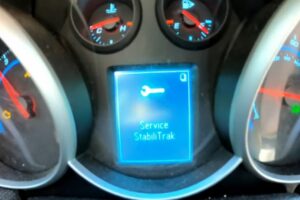If you’re wondering Can a Honda CR-V Be Flat Towed? the answer is yes! You can safely flat tow a Honda CR-V at speeds of up to 65 mph. This means you can easily bring your CR-V along on your next road trip without the need for a trailer.
Flat towing, also known as dinghy towing, involves towing a vehicle with all four wheels on the ground, without the need for a dolly or trailer.
The Honda CR-V is designed to be flat towed, making it a convenient option for those who want to bring their vehicle along on their adventures.
Just make sure to follow the manufacturer’s guidelines and use the proper equipment to ensure a safe and smooth towing experience. So, if you’re planning to hit the road with your Honda CR-V, rest assured that flat towing is a viable option.
Table of contents
Can a Honda CR-V Be Flat Towed?
Yes, some Honda CR-V models can be flat towed. However, not all models are compatible with flat towing, and there are specific procedures that must be followed in order to do it safely.
Which Honda CR-V models can be flat towed?
Honda CR-V models that can be flat towed include:
- 2003-2014 CR-Vs with front-wheel drive (FWD) or all-wheel drive (AWD)
- 2003-2014 CR-Vs with manual or automatic transmissions
How to flat tow a Honda CR-V
In order to flat tow a Honda CR-V safely, you will need to follow these procedures:
- Install a tow bar that is specifically designed for flat towing.
- Shift the transmission to neutral.
- Turn the ignition to the “accessory” position.
- Block the rear wheels.
- Engage the parking brake.
- Connect the tow bar to the tow vehicle.
What are the risks of flat towing a Honda CR-V?
If you do not follow the proper procedures for flat towing a Honda CR-V, you could damage the vehicle.
The most common risk is damage to the transfer case, which can occur if the wheels are not properly blocked. Other potential risks include damage to the transmission, brakes, and steering system.
Can newer Honda CR-V models be flat towed?
No, newer Honda CR-V models cannot be flat towed. This is because the design of the transfer case has changed in newer models, and flat towing can damage the vehicle.
If you are considering buying a Honda CR-V, and you plan to flat tow it, be sure to check the model year to make sure that it is compatible with flat towing. You can find this information in the owner’s manual.
Preparing Your Honda CR-V for Flat Towing:

If you’re planning to flat tow your Honda CR-V, there are a few important steps you need to take to ensure a safe and smooth towing experience. Here’s a breakdown of what you need to do:
Remember, flat towing a Honda CR-V can be a convenient option, but it’s essential to follow these preparation steps to ensure a safe and hassle-free towing experience.
By taking the time to prepare your vehicle properly, you can enjoy the freedom of towing your Honda CR-V behind your RV or any other towing vehicle.
| Step | Preparation |
|---|---|
| 1 | Check the owner’s manual |
| 2 | Verify towing capability |
| 3 | Prepare the vehicle |
| 4 | Attach the towing equipment |
| 5 | Test the lights and brakes |
Choosing the Right Towing Equipment:

When it comes to flat towing a Honda CR-V, having the right equipment is crucial for a safe and hassle-free experience. Here are a few key points to consider when choosing towing equipment:
Remember to consult the owner’s manual of your Honda CR-V for any specific recommendations or requirements regarding flat towing.
Additionally, it’s always a good idea to seek advice from towing experts or consult professionals to ensure you have the right equipment and setup for flat towing your Honda CR-V.
| Equipment | Considerations |
|---|---|
| Tow Bar | Choose one that is compatible with your CR-V’s weight and towing capacity |
| Base Plate | Ensure it fits your specific CR-V model year and is durable |
| Safety Cables | Select cables made of high-quality materials and with sufficient strength |
| Wiring and Lighting | Use a wiring harness designed for your CR-V model for seamless light functioning |
| Supplemental Brakes | Check local laws and regulations to determine if you need a supplemental system |
Proper Flat Towing Procedure:
When it comes to flat towing a Honda CR-V, following the proper procedure is crucial to ensure a safe and hassle-free towing experience. Here are some essential steps you should follow:
Remember, these steps are meant to provide a general outline for flat towing a Honda CR-V.
Always refer to the owner’s manual and any specific instructions provided by the manufacturer of your tow bar for the most accurate and up-to-date information.
By following the correct procedure, you can enjoy a smooth and worry-free towing experience with your Honda CR-V.
Safety Tips for Flat Towing:
When it comes to flat towing a Honda CR-V, safety should always be a top priority. Here are some essential tips to ensure a smooth and secure towing experience:
Remember, safety should never be compromised when flat towing a vehicle. By following these tips and adhering to the manufacturer’s guidelines, you can have a worry-free and secure towing experience with your Honda CR-V.
| Tips for Safe Flat Towing: |
|---|
| Consult the owner’s manual |
| Use the right equipment |
| Check the towing capacity |
| Inspect towing equipment regularly |
| Secure the vehicle properly |
| Practice safe driving techniques |
Maintenance and Care for a Flat Towed Honda CR-V:
When it comes to flat towing a Honda CR-V, proper maintenance and care are essential to ensure a safe and smooth towing experience. Here are some important points to keep in mind:
1. Consult the Owner’s Manual:
Before you start flat towing your Honda CR-V, it’s crucial to refer to the vehicle’s owner’s manual.
The manual will provide you with specific guidelines and instructions from the manufacturer regarding flat towing procedures, recommended equipment, and any necessary precautions.
2. Use a Quality Tow Bar and Base Plate:
Investing in a high-quality tow bar and base plate specifically designed for your Honda CR-V is crucial.
These components serve as the connection between your motorhome and the towed vehicle, and they need to be sturdy and reliable. Make sure to choose a tow bar with the appropriate weight capacity for your CR-V.
3. Follow Proper Hookup and Disconnect Procedures:
When connecting your Honda CR-V to the tow vehicle, always follow the proper hookup procedures recommended by the manufacturer.
This typically involves attaching the tow bar and base plate securely, connecting safety cables, and ensuring all electrical connections are in place.
When disconnecting, be sure to follow the reverse procedure, taking care to release any locks or mechanisms properly. It’s crucial to double-check all connections before hitting the road.
4. Regularly Inspect and Maintain the Towing Equipment:
Regular inspection and maintenance of your towing equipment are essential for safe and trouble-free towing. Inspect the tow bar, base plate, safety cables, and electrical connections before each trip.
Look for any signs of wear, damage, or corrosion and address any issues promptly.
5. Perform Routine Maintenance on Your Honda CR-V:
In addition to towing equipment, it’s vital to stay on top of routine maintenance for your Honda CR-V.
This includes regular oil changes, tire rotations, and brake inspections. Following the manufacturer’s recommended maintenance schedule will help ensure that your vehicle remains in good condition while being flat towed.
Remember, proper care and maintenance are crucial for a safe and enjoyable flat towing experience with your Honda CR-V.
By following the guidelines outlined in the owner’s manual and taking proactive measures, you can confidently hit the road and explore new destinations with your towed vehicle in tow.
| Maintenance Tips |
|---|
| – Refer to the owner’s manual for specific guidelines |
| – Use a high-quality tow bar and base plate |
| – Follow proper hookup and disconnect procedures |
| – Regularly inspect and maintain towing equipment |
| – Perform routine maintenance on your Honda CR-V |
Conclusion and final thoughts 💭
The Honda CR-V is indeed capable of being flat towed, providing a convenient option for those who want to bring their vehicle along for their outdoor adventures.
With a few considerations and precautions, you can safely tow your CR-V behind your motorhome without any issues.
Here are the key points to remember:
Remember, always prioritize safety when flat towing any vehicle. If you have any doubts or concerns, it’s best to consult with a professional or contact Honda directly for further guidance.
Happy towing and enjoy your travels with your Honda CR-V!
Latest Posts:
- Can WD-40 Remove Scratches on Cars? (Hint: Yes, but…)
- Can You Use a Drill to Polish Your Car? (We Tried it Out!)
- Should You Cover Car Scratches With Stickers? (REVEALED!)
- Buick Service Stabilitrak: (Causes & 100% Guaranteed Fix!)
- Common Holden Trax Problems (Causes & 100% Proven Fixes!)
- Jeep Commander Transmission Over Temp: (Guaranteed Fix!)












Leave a Reply